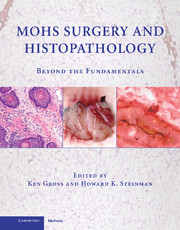Book contents
- Frontmatter
- Contents
- CONTRIBUTORS
- MOHS SURGERY AND HISTOPATHOLOGY
- PART I MICROSCOPY AND TISSUE PREPARATION
- PART II INTRODUCTION TO LABORATORY TECHNIQUES
- Chap. 6 LAB PEARLS: MAKING GREAT SLIDES
- Chap. 7 LAB PEARLS: STAINING, INKING, AND COVERSLIPPING
- Chap. 8 LAB PEARLS: TROUBLESHOOTING SLIDE QUALITY
- Chap. 9 MOHS SLIDES ORGANIZATION AND STANDARDIZATION FOR EFFECTIVE INTERPRETATION
- Chap. 10 MOHS MAPPING
- PART III MICROANATOMY AND NEOPLASTIC DISEASE
- PART IV SPECIAL TECHNIQUES AND STAINS
- INDEX
Chap. 6 - LAB PEARLS: MAKING GREAT SLIDES
from PART II - INTRODUCTION TO LABORATORY TECHNIQUES
Published online by Cambridge University Press: 03 March 2010
- Frontmatter
- Contents
- CONTRIBUTORS
- MOHS SURGERY AND HISTOPATHOLOGY
- PART I MICROSCOPY AND TISSUE PREPARATION
- PART II INTRODUCTION TO LABORATORY TECHNIQUES
- Chap. 6 LAB PEARLS: MAKING GREAT SLIDES
- Chap. 7 LAB PEARLS: STAINING, INKING, AND COVERSLIPPING
- Chap. 8 LAB PEARLS: TROUBLESHOOTING SLIDE QUALITY
- Chap. 9 MOHS SLIDES ORGANIZATION AND STANDARDIZATION FOR EFFECTIVE INTERPRETATION
- Chap. 10 MOHS MAPPING
- PART III MICROANATOMY AND NEOPLASTIC DISEASE
- PART IV SPECIAL TECHNIQUES AND STAINS
- INDEX
Summary
MOHS TECHNICIANS have one primary goal: the production of perfect slides. Consistently making high-quality slides has as much to do with problem solving as with technical skill. Problem-solving ability comes with experience. This chapter will discuss techniques and problem-solving skills that the author has found aid in producing excellent slides.
LAB EQUIPMENT
High-quality slide production requires well-functioning and well-maintained lab equipment. It is surprising how poorly the cryostats in some laboratories cut tissue. This is usually the result of years of poor maintenance. Cryostat refrigeration and microtome components must be serviced at least every six to 12 months to cut tissue properly. Without a properly cutting cryostat, it is nearly impossible to make excellent slides. When working with a poorly maintained cryostat, the technician can only partially compensate for the “play” in the microtome. Such cryostats will usually alternately cut thick and thin wafers. When this happens, the technician often places the thick wafers on the slides and discards the thin ones. When presented with a cryostat in need of repair, the technician should arrange for microtome maintenance before the next Mohs surgery session.
SPECIMEN RETRIEVAL
During specimen transfer from the patient to the Mohs laboratory, many things can go wrong: specimens may be misoriented on the transfer medium, become lost, or assigned to the wrong map. These errors can be minimized by establishing a specimen retrieval protocol in which each step of specimen transfer to the Mohs laboratory is addressed.
- Type
- Chapter
- Information
- Mohs Surgery and HistopathologyBeyond the Fundamentals, pp. 37 - 56Publisher: Cambridge University PressPrint publication year: 2009
- 1
- Cited by



